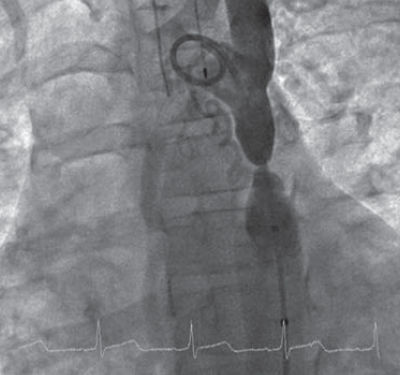Current approaches for aortic narrowing
Recent advances in stent technology show promise for patients with narrowing in the body’s main artery.
Published online 31 January 2016

Inserting a metal tube to widen the aorta can be a life-saving procedure for a common lesion that causes narrowing of the important artery.
© QSceince / H. Suradi
Coarctation of the aorta is the sixth most common lesion in congenital heart disease. It involves often-life-threatening narrowing in the aorta, the body’s main artery, as it leaves the heart. Management options vary and can be followed by recurrence or the formation of an aneurysm — a widening and dangerous weakening in the arterial wall.
Cardiologists from Rush University Medical Center in the United States reviewed current surgical and non-surgical treatment options for coarctation patients, publishing their findings in the Global Cardiology Science & Practice journal1.
“The choice of intervention should be determined by a multidisciplinary team experienced in treating patients with congenital heart disease and is dependent on the underlying morphology, age of the patient and the presence or absence of other cardiac lesions,” they write.
Neonates and young infants with critical coarctation are recommended to undergo surgical correction, which often involves the removal of the narrowed portion of the aorta followed by reconnecting the normal opposing parts. This treatment option involves a lower risk for re-intervention for these patients compared to other techniques.
The Rush University Medical Center team prefer balloon angioplasty for older infants and children between the ages of four months and five years unless there are complications with the condition. This involves inserting and inflating a tiny balloon in the aorta at the point of constriction, opening up the area, followed by its removal.
Stenting is now the preferred approach for older children heavier than 25 kilogrammes and adults. Various kinds of stents are available for interventional cardiologists to choose from, depending on the characteristics of the narrowing, but generally they involve inserting a metal tube into the narrowed area, which opens it up and allows blood to freely flow through it.
“One of the promising recent advances in stent technology is the development of biodegradable stents,” says cardiologist Hussam Suradi, the lead author of the paper. These are stents that keep the narrowed aortic segment open then dissolve over a period of months. The remaining scaffolding is believed to prevent significant future re-narrowing, but clinical trials are yet to show the feasibility and efficacy of this new technology.
Suradi and colleague Ziyad Hijazi recommend that future work needs to be directed toward improving the procedural approaches to treatment in order to improve the long-term survival of patients with coarctation of the aorta.
Reference
- Suradi, H. & Hijazi, Z. M. Current management of coarctation of the aorta. Glob. Cardiol. Sci. Pract. 2015, 44(2015). | article
DOI: 10.1038/qsh.2016.98

